Design & Safety of Hydraulic System for a Tube Swaging Machine
VerifiedAdded on 2023/06/11
|5
|1685
|445
Report
AI Summary
This report details the design and safety considerations for a hydraulic system used in a tube swaging machine. It argues for the suitability of hydraulics over pneumatics due to its greater power, simpler equipment, and faster action. The report outlines the technical requirements and commercial specifications, including speed of operation, power source, pressure requirements, sensors, alarm systems, cylinder capacity, operational efficiency, cooling type, and operator-friendliness. Commissioning procedures and maintenance strategies, focusing on predictive and preventive techniques, are also discussed, along with capital and running cost considerations. Furthermore, the report addresses safety legislation, potential dangers, and essential safety features such as lockout facilities, automatic cut-outs, emergency stops, and fail-safe mechanisms. Safety policies are recommended to mitigate overheating, fluid level issues, power overloads, and leaks. This document is available on Desklib, a platform offering a wide range of study resources for students.
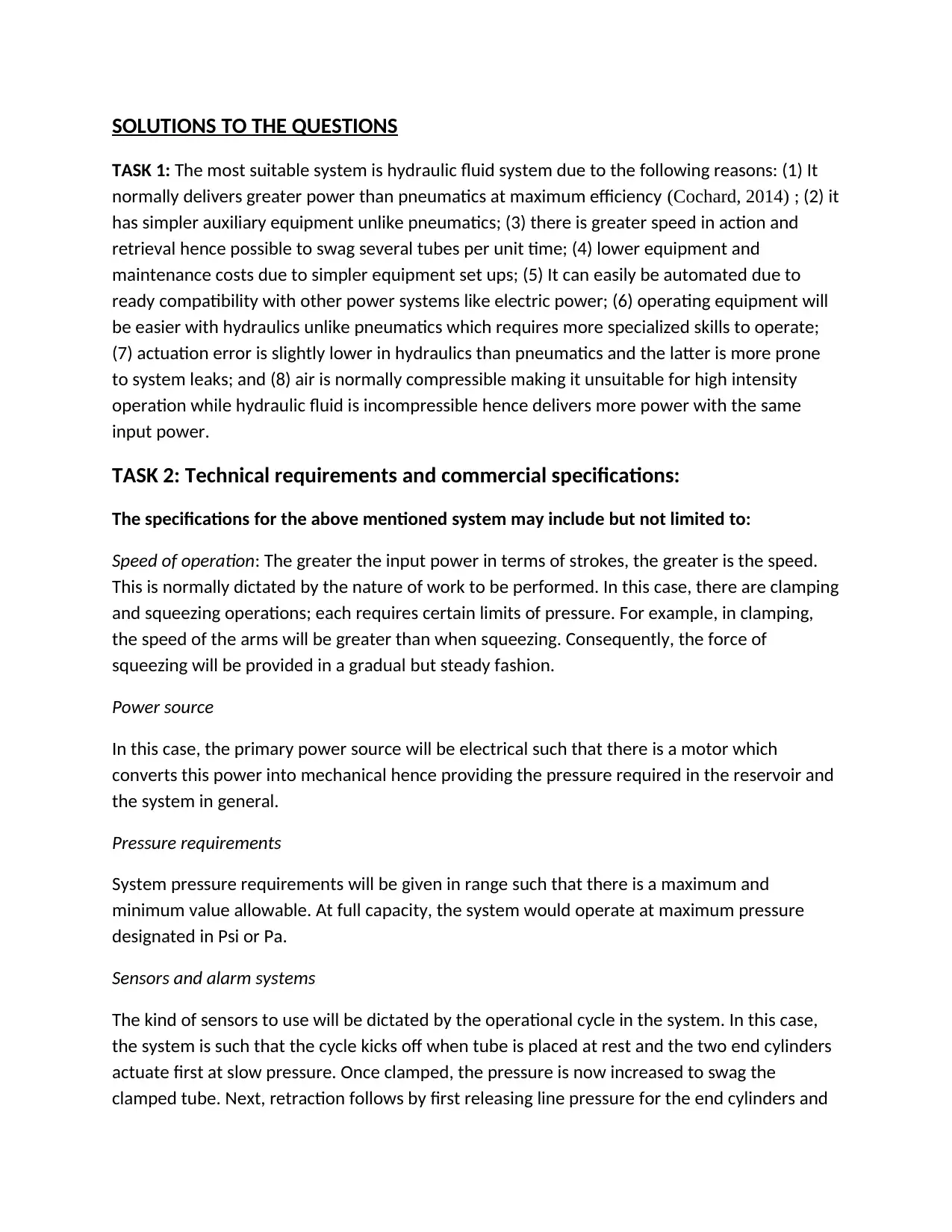
SOLUTIONS TO THE QUESTIONS
TASK 1: The most suitable system is hydraulic fluid system due to the following reasons: (1) It
normally delivers greater power than pneumatics at maximum efficiency (Cochard, 2014) ; (2) it
has simpler auxiliary equipment unlike pneumatics; (3) there is greater speed in action and
retrieval hence possible to swag several tubes per unit time; (4) lower equipment and
maintenance costs due to simpler equipment set ups; (5) It can easily be automated due to
ready compatibility with other power systems like electric power; (6) operating equipment will
be easier with hydraulics unlike pneumatics which requires more specialized skills to operate;
(7) actuation error is slightly lower in hydraulics than pneumatics and the latter is more prone
to system leaks; and (8) air is normally compressible making it unsuitable for high intensity
operation while hydraulic fluid is incompressible hence delivers more power with the same
input power.
TASK 2: Technical requirements and commercial specifications:
The specifications for the above mentioned system may include but not limited to:
Speed of operation: The greater the input power in terms of strokes, the greater is the speed.
This is normally dictated by the nature of work to be performed. In this case, there are clamping
and squeezing operations; each requires certain limits of pressure. For example, in clamping,
the speed of the arms will be greater than when squeezing. Consequently, the force of
squeezing will be provided in a gradual but steady fashion.
Power source
In this case, the primary power source will be electrical such that there is a motor which
converts this power into mechanical hence providing the pressure required in the reservoir and
the system in general.
Pressure requirements
System pressure requirements will be given in range such that there is a maximum and
minimum value allowable. At full capacity, the system would operate at maximum pressure
designated in Psi or Pa.
Sensors and alarm systems
The kind of sensors to use will be dictated by the operational cycle in the system. In this case,
the system is such that the cycle kicks off when tube is placed at rest and the two end cylinders
actuate first at slow pressure. Once clamped, the pressure is now increased to swag the
clamped tube. Next, retraction follows by first releasing line pressure for the end cylinders and
TASK 1: The most suitable system is hydraulic fluid system due to the following reasons: (1) It
normally delivers greater power than pneumatics at maximum efficiency (Cochard, 2014) ; (2) it
has simpler auxiliary equipment unlike pneumatics; (3) there is greater speed in action and
retrieval hence possible to swag several tubes per unit time; (4) lower equipment and
maintenance costs due to simpler equipment set ups; (5) It can easily be automated due to
ready compatibility with other power systems like electric power; (6) operating equipment will
be easier with hydraulics unlike pneumatics which requires more specialized skills to operate;
(7) actuation error is slightly lower in hydraulics than pneumatics and the latter is more prone
to system leaks; and (8) air is normally compressible making it unsuitable for high intensity
operation while hydraulic fluid is incompressible hence delivers more power with the same
input power.
TASK 2: Technical requirements and commercial specifications:
The specifications for the above mentioned system may include but not limited to:
Speed of operation: The greater the input power in terms of strokes, the greater is the speed.
This is normally dictated by the nature of work to be performed. In this case, there are clamping
and squeezing operations; each requires certain limits of pressure. For example, in clamping,
the speed of the arms will be greater than when squeezing. Consequently, the force of
squeezing will be provided in a gradual but steady fashion.
Power source
In this case, the primary power source will be electrical such that there is a motor which
converts this power into mechanical hence providing the pressure required in the reservoir and
the system in general.
Pressure requirements
System pressure requirements will be given in range such that there is a maximum and
minimum value allowable. At full capacity, the system would operate at maximum pressure
designated in Psi or Pa.
Sensors and alarm systems
The kind of sensors to use will be dictated by the operational cycle in the system. In this case,
the system is such that the cycle kicks off when tube is placed at rest and the two end cylinders
actuate first at slow pressure. Once clamped, the pressure is now increased to swag the
clamped tube. Next, retraction follows by first releasing line pressure for the end cylinders and
Paraphrase This Document
Need a fresh take? Get an instant paraphrase of this document with our AI Paraphraser
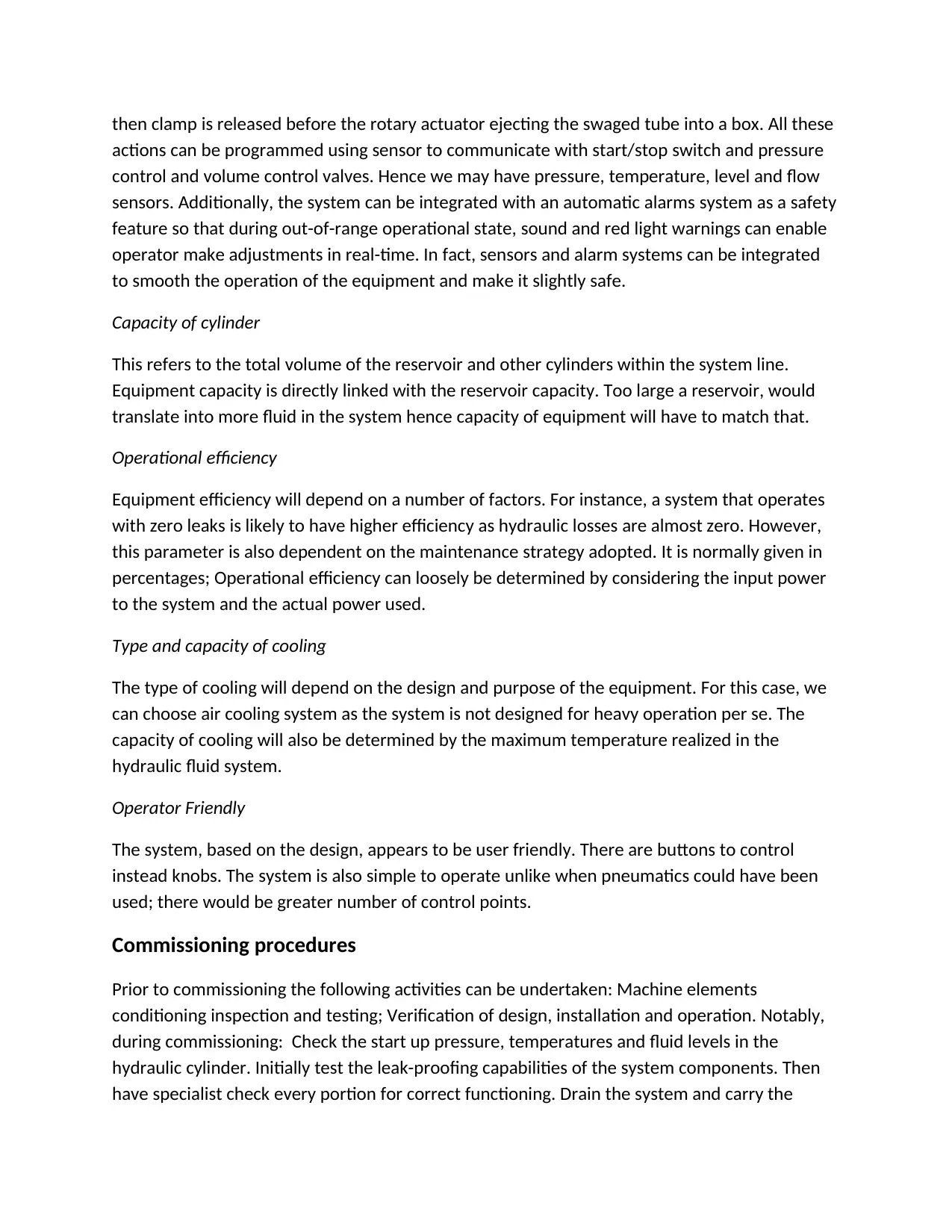
then clamp is released before the rotary actuator ejecting the swaged tube into a box. All these
actions can be programmed using sensor to communicate with start/stop switch and pressure
control and volume control valves. Hence we may have pressure, temperature, level and flow
sensors. Additionally, the system can be integrated with an automatic alarms system as a safety
feature so that during out-of-range operational state, sound and red light warnings can enable
operator make adjustments in real-time. In fact, sensors and alarm systems can be integrated
to smooth the operation of the equipment and make it slightly safe.
Capacity of cylinder
This refers to the total volume of the reservoir and other cylinders within the system line.
Equipment capacity is directly linked with the reservoir capacity. Too large a reservoir, would
translate into more fluid in the system hence capacity of equipment will have to match that.
Operational efficiency
Equipment efficiency will depend on a number of factors. For instance, a system that operates
with zero leaks is likely to have higher efficiency as hydraulic losses are almost zero. However,
this parameter is also dependent on the maintenance strategy adopted. It is normally given in
percentages; Operational efficiency can loosely be determined by considering the input power
to the system and the actual power used.
Type and capacity of cooling
The type of cooling will depend on the design and purpose of the equipment. For this case, we
can choose air cooling system as the system is not designed for heavy operation per se. The
capacity of cooling will also be determined by the maximum temperature realized in the
hydraulic fluid system.
Operator Friendly
The system, based on the design, appears to be user friendly. There are buttons to control
instead knobs. The system is also simple to operate unlike when pneumatics could have been
used; there would be greater number of control points.
Commissioning procedures
Prior to commissioning the following activities can be undertaken: Machine elements
conditioning inspection and testing; Verification of design, installation and operation. Notably,
during commissioning: Check the start up pressure, temperatures and fluid levels in the
hydraulic cylinder. Initially test the leak-proofing capabilities of the system components. Then
have specialist check every portion for correct functioning. Drain the system and carry the
actions can be programmed using sensor to communicate with start/stop switch and pressure
control and volume control valves. Hence we may have pressure, temperature, level and flow
sensors. Additionally, the system can be integrated with an automatic alarms system as a safety
feature so that during out-of-range operational state, sound and red light warnings can enable
operator make adjustments in real-time. In fact, sensors and alarm systems can be integrated
to smooth the operation of the equipment and make it slightly safe.
Capacity of cylinder
This refers to the total volume of the reservoir and other cylinders within the system line.
Equipment capacity is directly linked with the reservoir capacity. Too large a reservoir, would
translate into more fluid in the system hence capacity of equipment will have to match that.
Operational efficiency
Equipment efficiency will depend on a number of factors. For instance, a system that operates
with zero leaks is likely to have higher efficiency as hydraulic losses are almost zero. However,
this parameter is also dependent on the maintenance strategy adopted. It is normally given in
percentages; Operational efficiency can loosely be determined by considering the input power
to the system and the actual power used.
Type and capacity of cooling
The type of cooling will depend on the design and purpose of the equipment. For this case, we
can choose air cooling system as the system is not designed for heavy operation per se. The
capacity of cooling will also be determined by the maximum temperature realized in the
hydraulic fluid system.
Operator Friendly
The system, based on the design, appears to be user friendly. There are buttons to control
instead knobs. The system is also simple to operate unlike when pneumatics could have been
used; there would be greater number of control points.
Commissioning procedures
Prior to commissioning the following activities can be undertaken: Machine elements
conditioning inspection and testing; Verification of design, installation and operation. Notably,
during commissioning: Check the start up pressure, temperatures and fluid levels in the
hydraulic cylinder. Initially test the leak-proofing capabilities of the system components. Then
have specialist check every portion for correct functioning. Drain the system and carry the
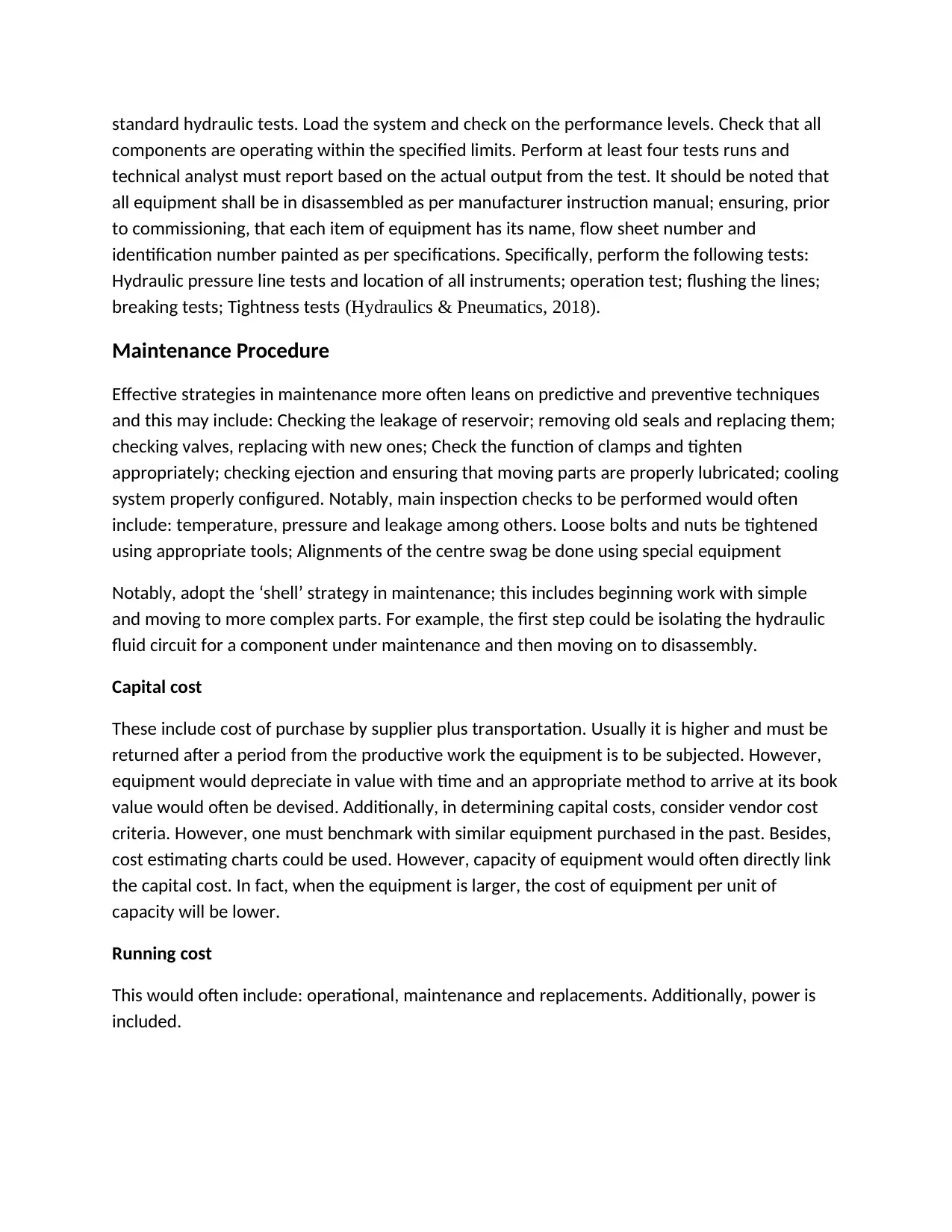
standard hydraulic tests. Load the system and check on the performance levels. Check that all
components are operating within the specified limits. Perform at least four tests runs and
technical analyst must report based on the actual output from the test. It should be noted that
all equipment shall be in disassembled as per manufacturer instruction manual; ensuring, prior
to commissioning, that each item of equipment has its name, flow sheet number and
identification number painted as per specifications. Specifically, perform the following tests:
Hydraulic pressure line tests and location of all instruments; operation test; flushing the lines;
breaking tests; Tightness tests (Hydraulics & Pneumatics, 2018).
Maintenance Procedure
Effective strategies in maintenance more often leans on predictive and preventive techniques
and this may include: Checking the leakage of reservoir; removing old seals and replacing them;
checking valves, replacing with new ones; Check the function of clamps and tighten
appropriately; checking ejection and ensuring that moving parts are properly lubricated; cooling
system properly configured. Notably, main inspection checks to be performed would often
include: temperature, pressure and leakage among others. Loose bolts and nuts be tightened
using appropriate tools; Alignments of the centre swag be done using special equipment
Notably, adopt the ‘shell’ strategy in maintenance; this includes beginning work with simple
and moving to more complex parts. For example, the first step could be isolating the hydraulic
fluid circuit for a component under maintenance and then moving on to disassembly.
Capital cost
These include cost of purchase by supplier plus transportation. Usually it is higher and must be
returned after a period from the productive work the equipment is to be subjected. However,
equipment would depreciate in value with time and an appropriate method to arrive at its book
value would often be devised. Additionally, in determining capital costs, consider vendor cost
criteria. However, one must benchmark with similar equipment purchased in the past. Besides,
cost estimating charts could be used. However, capacity of equipment would often directly link
the capital cost. In fact, when the equipment is larger, the cost of equipment per unit of
capacity will be lower.
Running cost
This would often include: operational, maintenance and replacements. Additionally, power is
included.
components are operating within the specified limits. Perform at least four tests runs and
technical analyst must report based on the actual output from the test. It should be noted that
all equipment shall be in disassembled as per manufacturer instruction manual; ensuring, prior
to commissioning, that each item of equipment has its name, flow sheet number and
identification number painted as per specifications. Specifically, perform the following tests:
Hydraulic pressure line tests and location of all instruments; operation test; flushing the lines;
breaking tests; Tightness tests (Hydraulics & Pneumatics, 2018).
Maintenance Procedure
Effective strategies in maintenance more often leans on predictive and preventive techniques
and this may include: Checking the leakage of reservoir; removing old seals and replacing them;
checking valves, replacing with new ones; Check the function of clamps and tighten
appropriately; checking ejection and ensuring that moving parts are properly lubricated; cooling
system properly configured. Notably, main inspection checks to be performed would often
include: temperature, pressure and leakage among others. Loose bolts and nuts be tightened
using appropriate tools; Alignments of the centre swag be done using special equipment
Notably, adopt the ‘shell’ strategy in maintenance; this includes beginning work with simple
and moving to more complex parts. For example, the first step could be isolating the hydraulic
fluid circuit for a component under maintenance and then moving on to disassembly.
Capital cost
These include cost of purchase by supplier plus transportation. Usually it is higher and must be
returned after a period from the productive work the equipment is to be subjected. However,
equipment would depreciate in value with time and an appropriate method to arrive at its book
value would often be devised. Additionally, in determining capital costs, consider vendor cost
criteria. However, one must benchmark with similar equipment purchased in the past. Besides,
cost estimating charts could be used. However, capacity of equipment would often directly link
the capital cost. In fact, when the equipment is larger, the cost of equipment per unit of
capacity will be lower.
Running cost
This would often include: operational, maintenance and replacements. Additionally, power is
included.
⊘ This is a preview!⊘
Do you want full access?
Subscribe today to unlock all pages.

Trusted by 1+ million students worldwide
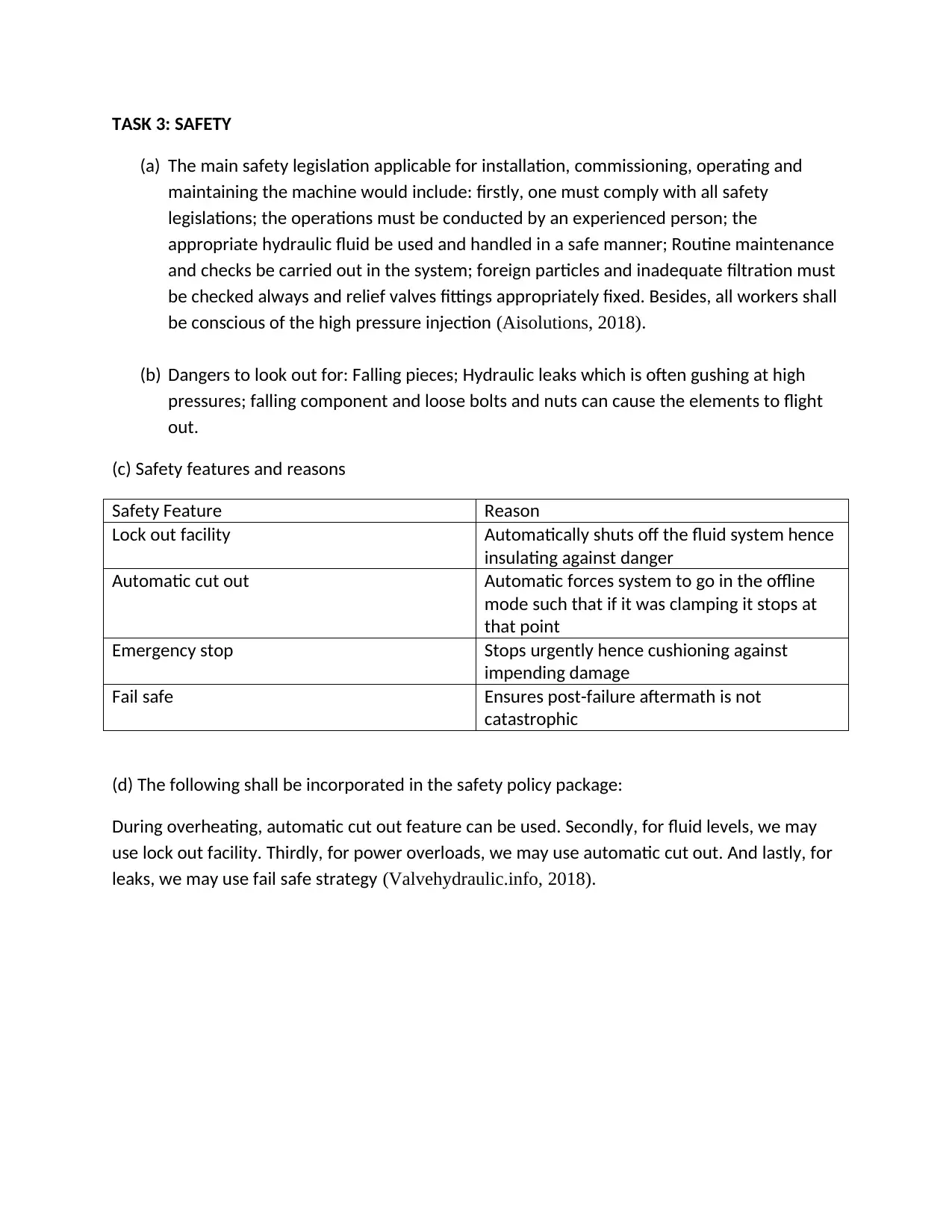
TASK 3: SAFETY
(a) The main safety legislation applicable for installation, commissioning, operating and
maintaining the machine would include: firstly, one must comply with all safety
legislations; the operations must be conducted by an experienced person; the
appropriate hydraulic fluid be used and handled in a safe manner; Routine maintenance
and checks be carried out in the system; foreign particles and inadequate filtration must
be checked always and relief valves fittings appropriately fixed. Besides, all workers shall
be conscious of the high pressure injection (Aisolutions, 2018).
(b) Dangers to look out for: Falling pieces; Hydraulic leaks which is often gushing at high
pressures; falling component and loose bolts and nuts can cause the elements to flight
out.
(c) Safety features and reasons
Safety Feature Reason
Lock out facility Automatically shuts off the fluid system hence
insulating against danger
Automatic cut out Automatic forces system to go in the offline
mode such that if it was clamping it stops at
that point
Emergency stop Stops urgently hence cushioning against
impending damage
Fail safe Ensures post-failure aftermath is not
catastrophic
(d) The following shall be incorporated in the safety policy package:
During overheating, automatic cut out feature can be used. Secondly, for fluid levels, we may
use lock out facility. Thirdly, for power overloads, we may use automatic cut out. And lastly, for
leaks, we may use fail safe strategy (Valvehydraulic.info, 2018).
(a) The main safety legislation applicable for installation, commissioning, operating and
maintaining the machine would include: firstly, one must comply with all safety
legislations; the operations must be conducted by an experienced person; the
appropriate hydraulic fluid be used and handled in a safe manner; Routine maintenance
and checks be carried out in the system; foreign particles and inadequate filtration must
be checked always and relief valves fittings appropriately fixed. Besides, all workers shall
be conscious of the high pressure injection (Aisolutions, 2018).
(b) Dangers to look out for: Falling pieces; Hydraulic leaks which is often gushing at high
pressures; falling component and loose bolts and nuts can cause the elements to flight
out.
(c) Safety features and reasons
Safety Feature Reason
Lock out facility Automatically shuts off the fluid system hence
insulating against danger
Automatic cut out Automatic forces system to go in the offline
mode such that if it was clamping it stops at
that point
Emergency stop Stops urgently hence cushioning against
impending damage
Fail safe Ensures post-failure aftermath is not
catastrophic
(d) The following shall be incorporated in the safety policy package:
During overheating, automatic cut out feature can be used. Secondly, for fluid levels, we may
use lock out facility. Thirdly, for power overloads, we may use automatic cut out. And lastly, for
leaks, we may use fail safe strategy (Valvehydraulic.info, 2018).
Paraphrase This Document
Need a fresh take? Get an instant paraphrase of this document with our AI Paraphraser
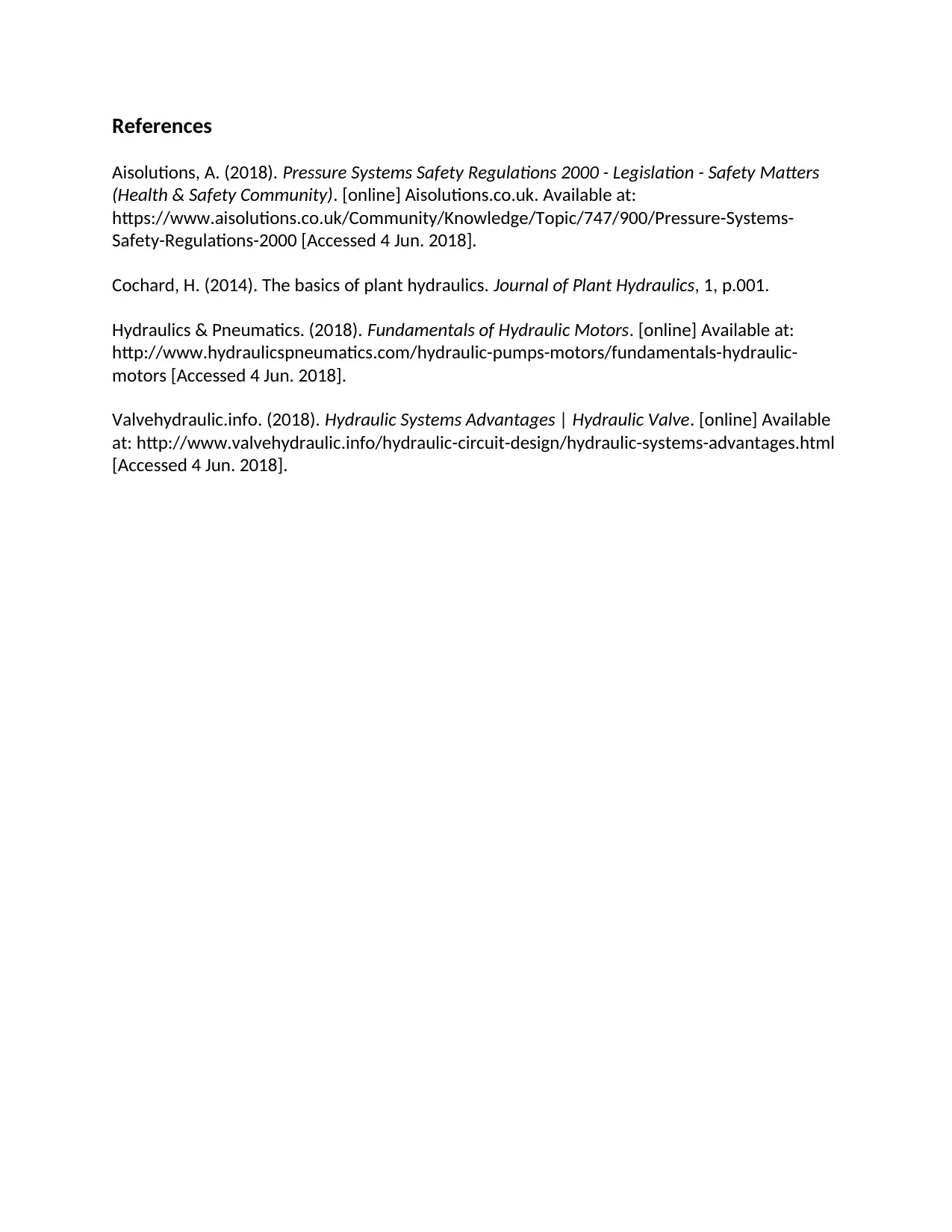
References
Aisolutions, A. (2018). Pressure Systems Safety Regulations 2000 - Legislation - Safety Matters
(Health & Safety Community). [online] Aisolutions.co.uk. Available at:
https://www.aisolutions.co.uk/Community/Knowledge/Topic/747/900/Pressure-Systems-
Safety-Regulations-2000 [Accessed 4 Jun. 2018].
Cochard, H. (2014). The basics of plant hydraulics. Journal of Plant Hydraulics, 1, p.001.
Hydraulics & Pneumatics. (2018). Fundamentals of Hydraulic Motors. [online] Available at:
http://www.hydraulicspneumatics.com/hydraulic-pumps-motors/fundamentals-hydraulic-
motors [Accessed 4 Jun. 2018].
Valvehydraulic.info. (2018). Hydraulic Systems Advantages | Hydraulic Valve. [online] Available
at: http://www.valvehydraulic.info/hydraulic-circuit-design/hydraulic-systems-advantages.html
[Accessed 4 Jun. 2018].
Aisolutions, A. (2018). Pressure Systems Safety Regulations 2000 - Legislation - Safety Matters
(Health & Safety Community). [online] Aisolutions.co.uk. Available at:
https://www.aisolutions.co.uk/Community/Knowledge/Topic/747/900/Pressure-Systems-
Safety-Regulations-2000 [Accessed 4 Jun. 2018].
Cochard, H. (2014). The basics of plant hydraulics. Journal of Plant Hydraulics, 1, p.001.
Hydraulics & Pneumatics. (2018). Fundamentals of Hydraulic Motors. [online] Available at:
http://www.hydraulicspneumatics.com/hydraulic-pumps-motors/fundamentals-hydraulic-
motors [Accessed 4 Jun. 2018].
Valvehydraulic.info. (2018). Hydraulic Systems Advantages | Hydraulic Valve. [online] Available
at: http://www.valvehydraulic.info/hydraulic-circuit-design/hydraulic-systems-advantages.html
[Accessed 4 Jun. 2018].
1 out of 5
Your All-in-One AI-Powered Toolkit for Academic Success.
+13062052269
info@desklib.com
Available 24*7 on WhatsApp / Email
![[object Object]](/_next/static/media/star-bottom.7253800d.svg)
Unlock your academic potential
Copyright © 2020–2025 A2Z Services. All Rights Reserved. Developed and managed by ZUCOL.
